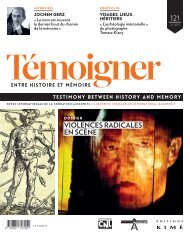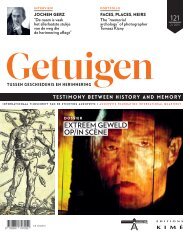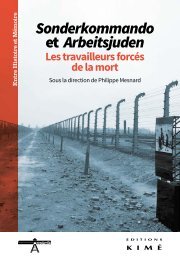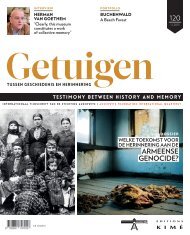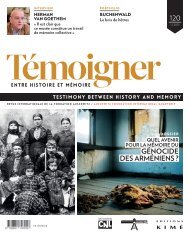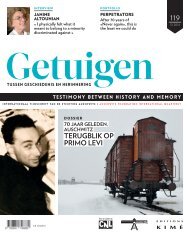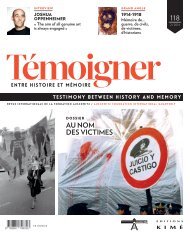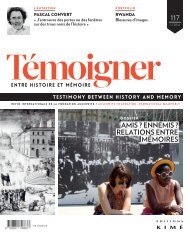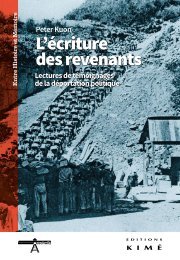Revue : Témoigner entre histoire et mémoire - n° 119 (décembre 2014) : Dossier : Il y a 70 ans, Auschwitz. Retour sur Primo Levi
27 janvier 1945. Il y a 70 ans les premiers soldats de l’Armée rouge pénétraient dans le camp d’Auschwitz marquant définitivement ce que l’on pourrait appeler sa « libération », bien qu’Auschwitz n’ait été, pas plus qu’aucun autre camp nazi, un objectif prioritaire pour aucune des forces alliées. Primo Levi faisait partie des quelques rescapés qui, échappant aux évacuations forcées, étaient restés cachés à Auschwitz. Juif, déporté, chimiste, témoin, écrivain, retour sur cette personnalité complexe, sur son ascension vers ce qu’il a appelé le « rescapé professionnel », sur son œuvre. Sur ce que les mots « résistance », « engagement » ont signifié pour lui.
27 janvier 1945. Il y a 70 ans les premiers soldats de l’Armée rouge pénétraient dans le camp d’Auschwitz marquant définitivement ce que l’on pourrait appeler sa « libération », bien qu’Auschwitz n’ait été, pas plus qu’aucun autre camp nazi, un objectif prioritaire pour aucune des forces alliées. Primo Levi faisait partie des quelques rescapés qui, échappant aux évacuations forcées, étaient restés cachés à Auschwitz. Juif, déporté, chimiste, témoin, écrivain, retour sur cette personnalité complexe, sur son ascension vers ce qu’il a appelé le « rescapé professionnel », sur son œuvre. Sur ce que les mots « résistance », « engagement » ont signifié pour lui.
- TAGS
- primo-levi
- auschwitz
Create successful ePaper yourself
Turn your PDF publications into a flip-book with our unique Google optimized e-Paper software.
Dictionary<br />
Dictionnaire<br />
testimonial <strong>et</strong> mémoriel<br />
MOTS DU TÉMOIGNAGE<br />
ET DE LA MÉMOIRE<br />
. Parce que les chercheurs, les<br />
enseignants <strong>et</strong> les professionnels<br />
des arts, de la culture <strong>et</strong> de<br />
l’information sont de plus en<br />
plus amenés à utiliser des mots<br />
appartenant au champ du<br />
témoignage <strong>et</strong> de la <strong>mémoire</strong>,<br />
<strong>Témoigner</strong> <strong>entre</strong> <strong>histoire</strong> <strong>et</strong><br />
<strong>mémoire</strong> s’est donné pour mission<br />
de les rassembler sous la forme<br />
d’un dictionnaire en ouvrant ainsi<br />
c<strong>et</strong> espace expérimental.<br />
. La réalisation de ce proj<strong>et</strong><br />
se fait en deux temps. Chaque<br />
terme d’un index in progress<br />
est présenté en deux fois : sous<br />
la forme de notices courtes,<br />
d’abord d<strong>ans</strong> chaque numéro de<br />
la revue, invitant ensuite à des<br />
développements <strong>et</strong> à une mise en<br />
débats critique, à plusieurs voix,<br />
<strong>sur</strong> un site qui fonctionnera à<br />
partir de début 2015.<br />
À leur version courte <strong>et</strong>, donc,<br />
volontairement partielle, nous<br />
associons quelques titres<br />
d’ouvrages ne prétendant pas à<br />
l’exhaustivité.<br />
ARCHAEOLOGY<br />
OF THE HOLOCAUST<br />
The archaeology of the Holocaust<br />
is the study of the<br />
material remains – sites<br />
and artifacts – that were associated<br />
with the persecution and<br />
mass murder of five to six million<br />
Jews by the Nazis during the<br />
Second World War. In fact, the<br />
locales of each of the hundreds of<br />
the Gh<strong>et</strong>tos are potential targ<strong>et</strong>s<br />
for archaeological investigations,<br />
but the greatest attention is paid<br />
to the Nazi extermination centers<br />
in Poland where the archaeological<br />
research is most intensive.<br />
The extermination centers<br />
of Chełmno, Bełżec, Sobibór and<br />
Treblinka have been, and are, subjected<br />
to archaeological research<br />
more than other sites. One of the<br />
significant results of the archaeological<br />
research is that although<br />
the Nazis levelled these sites,<br />
mostly in late 1943, remains of<br />
structures were found immediately<br />
below <strong>sur</strong>face, accompanied<br />
by a profusion of artifacts from<br />
the <strong>sur</strong>face and sub-<strong>sur</strong>face. Mass<br />
graves have been identified in all<br />
the above sites; the exact locations<br />
of the Bełżec, Sobibór and<br />
Treblinka gas chambers have not<br />
been discovered y<strong>et</strong>. In general<br />
terms, excavations of Holocaust<br />
sites started relatively recently and<br />
the volume of the research carried<br />
out up to now remains limited, the<br />
© I. Gilead<br />
trate it with the physical evidence<br />
that was preserved and can be<br />
revealed by archaeological m<strong>et</strong>hods.<br />
Archaeology is important in<br />
illuminating the topography of the<br />
concentration and extermination<br />
centers, as well as in revealing the<br />
artifacts of both the victims and the<br />
perp<strong>et</strong>rators, which are essential<br />
for the teaching of the Holocaust<br />
and creating museum collections<br />
that help preserve its memory. ❚<br />
Isaac Gilead<br />
Ben-Gurion University of the Negev,<br />
Beer Sheva, Israel<br />
LES FRONTOVIKI :<br />
ÉCRIVAINS COMBATTANTS<br />
SOVIÉTIQUES<br />
Ce mot désigne ceux qui ont<br />
une expérience du front,<br />
plus spécifiquement des<br />
fronts de la « Grande Guerre patriotique<br />
» (nom soviétique, puis russe<br />
de la Seconde Guerre mondiale),<br />
qu’ils aient pris part aux combats<br />
ou accompagné l’armée en tant que<br />
correspondants. D<strong>ans</strong> l’immense<br />
flot des textes qui ont pour suj<strong>et</strong> la<br />
guerre, on distingue ainsi ceux qui,<br />
indépendamment de leur forme<br />
(reportage, fiction, poésie), sont<br />
légitimés par le vécu personnel <strong>et</strong><br />
dont les auteurs se sont exposés au<br />
danger de mort. Dès le début de la<br />
guerre, les écrivains sont mobilisés<br />
pour produire un discours fédérateur<br />
appelé à consolider l’alliance<br />
du peuple soviétique <strong>et</strong> du gouvernement<br />
face à la menace de destruction<br />
radicale. C<strong>et</strong>te alliance<br />
se fait sous le signe d’une identité<br />
russe orthodoxe ainsi qu’en<br />
témoigne le célèbre discours de<br />
Staline du 3 juill<strong>et</strong> 1941, où il ressuscite<br />
la formule « Chers frères<br />
<strong>et</strong> sœurs » s’adressant aux citoyens<br />
publications are rare, the results<br />
preliminary and the conclusions<br />
tentative.<br />
One of the premises formulated<br />
by archaeologists and supported by<br />
the media is that archaeology can<br />
assert by excavations the truth of<br />
the Holocaust. However, the reality<br />
of the extermination has already<br />
been established by the historical<br />
research and local and international<br />
courts. The above premise,<br />
coupled with the pres<strong>sur</strong>e of the<br />
media to produce instant results<br />
in front of the cameras while in the<br />
field, is a threat to the integrity and<br />
credibility of Holocaust archaeology.<br />
More than once were archaeologists<br />
tempted to declare in the<br />
field that they stand in front of the<br />
remains of gas chambers, while the<br />
evidence they uncovered did not<br />
support such claims.<br />
Archaeology cannot establish,<br />
or refute, the truth of the Holocaust;<br />
it can support it and illussoviétiques<br />
comme un prêtre à ses<br />
paroissiens. La nouvelle identité<br />
vaut pour l’ensemble de l’Union<br />
conçue d<strong>ans</strong> sa dimension impériale<br />
: elle forme le contexte des<br />
déportations <strong>et</strong>hniques qui s’accomplissent<br />
au même moment <strong>et</strong><br />
annonce déjà la campagne antisémite<br />
de l’après-guerre.<br />
La littérature aura pour tâche à<br />
la fois d’expliquer <strong>et</strong> de justifier la<br />
débâcle de la première année de la<br />
guerre, de montrer l’héroïsme des<br />
Soviétiques (inspiré par le Parti <strong>et</strong><br />
la figure de Staline) <strong>et</strong> d’appeler à<br />
la vengeance contre les Allemands<br />
(Simonov, Ehrenbourg). Un certain<br />
nombre de tabous tenaces<br />
s’imposent, notamment <strong>sur</strong> la<br />
collaboration massive de la population<br />
des territoires occidentaux<br />
récemment annexés à l’URSS. Toutefois,<br />
le « pas en arrière » accompli<br />
par l’idéologie est perçu comme<br />
une certaine libéralisation, ce qui<br />
crée un bref espoir en une réconciliation<br />
<strong>entre</strong> le pouvoir <strong>et</strong> le peuple<br />
<strong>et</strong> en la fin des répressions. <strong>Il</strong><br />
souffle ainsi un léger vent de liberté<br />
d<strong>ans</strong> les tranchées, favorisé aussi<br />
par la violence totale à laquelle les<br />
frontoviki doivent faire face. Cela<br />
explique l’audace (relative) que<br />
se perm<strong>et</strong>tront certains écrivains<br />
comme Tvardovski avec son épopée<br />
Vassili Tiorkine, où le nom de<br />
Staline n’est pas mentionné, ou<br />
Nekrassov dont D<strong>ans</strong> les tranchées<br />
de Stalingrad s’écarte de la ligne<br />
officielle.<br />
Le label de frontovik apparaît<br />
d<strong>ans</strong> l’espace littéraire soviétique<br />
comme garant d’une vérité factuelle<br />
<strong>et</strong> psychologique, attestée<br />
par la condition de témoin oculaire<br />
<strong>et</strong> contrôlée en haut lieu. La<br />
littérature de la guerre sera ainsi<br />
l’occasion de perfectionner le<br />
canon imposé au témoignage écrit,<br />
envisagé d’emblée comme une<br />
construction (<strong>et</strong> toujours supervisé<br />
par un écrivain de métier), jamais<br />
comme l’expression spontanée<br />
d’une subjectivité aux prises avec<br />
le vécu. Cependant, si la plupart<br />
du temps, la « vraie guerre » est<br />
tue ou consignée d<strong>ans</strong> les journaux<br />
intimes, l’épreuve de la vérité<br />
conduira certains de ces écrivains<br />
à la contestation (Tvardovski), à<br />
la dissidence (Nekrassov), voire à<br />
l’affrontement direct avec le parti<br />
(Grossman). ❚<br />
Luba Jurgenson<br />
EUR’ORBEM<br />
. Vassili Grossman, Années de guerre,<br />
Éditions en langues étrangères,<br />
Moscou, 1946 ; Vie <strong>et</strong> Destin in<br />
Œuvres, Paris, Laffont, 2006 ; Carn<strong>et</strong>s<br />
de Guerre, Paris, Calmann-Lévy, 2005.<br />
. Viktor Nekrassov, D<strong>ans</strong> les<br />
tranchées de Stalingrad, Paris, Presses<br />
de la Cité, 1963.<br />
. Alexandre Tvardovski, Vassili<br />
Tiorkine d<strong>ans</strong> l’autre monde, Lausanne,<br />
l’Age d’Homme, 1990.<br />
. Constantin Simonov, Les Jours <strong>et</strong><br />
les nuits de Stalingrad – récit d’un<br />
témoin, Paris, éd. Colbert, 1945.<br />
GEOFFREY HARTMAN<br />
Geoffrey Hartman (1929- ) is<br />
a Jewish American literary<br />
critic and theorist, who has<br />
since the beginning of the 1980s<br />
made important contributions in<br />
the domains of Holocaust studies,<br />
cultural memory studies, trauma<br />
theory, as well as Jewish studies.<br />
Hartman was centrally involved<br />
in establishing what is now the<br />
Fortunoff Video Archive at Yale<br />
University in the early 1980s, and<br />
in developing it into an important<br />
initiative for the visual recording of<br />
Holocaust testimony. Much of his<br />
172 <strong>Témoigner</strong> <strong>entre</strong> <strong>histoire</strong> <strong>et</strong> <strong>mémoire</strong> – <strong>n°</strong><strong>119</strong> / Décembre <strong>2014</strong> Testimony B<strong>et</strong>ween History and Memory – <strong>n°</strong><strong>119</strong> / December <strong>2014</strong><br />
173



